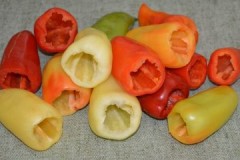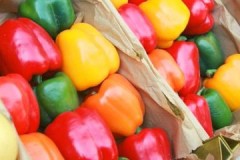Practical recommendations on where and how to store bell peppers so that they turn red
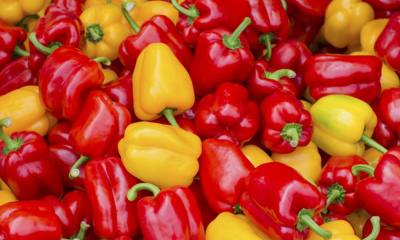 In anticipation of frost, the harvest of bell peppers is removed from the beds. Sweet, fleshy fruits will become part of tasty and healthy dishes.
In anticipation of frost, the harvest of bell peppers is removed from the beds. Sweet, fleshy fruits will become part of tasty and healthy dishes.
But unripe ones (you can identify them by their pale green color) will have to be sent for ripening.
How to properly and where to store not fully ripened bell pepper fruits so that they turn red faster, we will consider in more detail.
Content
Criteria for ripening
In order for unripe peppers to turn into fleshy, juicy vegetables, it is important to provide optimal conditions for ripening.
If necessary, a bucket of water will help increase the air humidity. (set out for three to four hours in the room where vegetables are stored). If the humidity needs to be reduced, instead of water, fill the bucket with coal or salt.
The third, very important criterion for the quality ripening of bell peppers is the absence of light. Direct sunlight is the enemy of an unripe fruit (in bright light, vegetables spoil very quickly).
It is worth remembering: under optimal conditions, bell peppers ripen in twenty to thirty days.
Fruits of technical maturity are selected for ripening. This means that the pepper has already reached the size corresponding to the variety, but has not had time to turn the desired color.
At the stage of technical maturity, pepper has time to accumulate the maximum amount of vitamins and nutrients, which makes it suitable for consumption after ripening.
How to keep it fresh at home?
In a city apartment, the best place to store unripe bell peppers is a balcony (loggia).
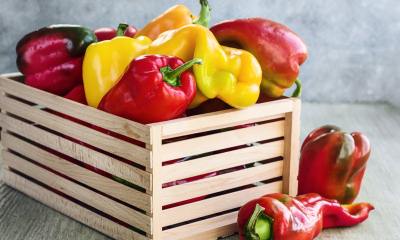 In order for vegetables to ripen during storage, it is necessary:
In order for vegetables to ripen during storage, it is necessary:
- Select the right size wooden or cardboard box with holes (the container must be clean, dry, strong).
- Line the bottom of the box with paper (cover with a layer of sand or sawdust).
- Lay unripe fruits in layers.
- Cover the top layer with thick paper or a clean cloth and place the box in a dark, cool place.
The optimal number of layers of peppers in a box is three (otherwise there is a high risk of damage to the crop).
Another option for storing unripe peppers is the refrigerator. Algorithm of actions:
- the fruits are carefully sorted, removing rotten and damaged specimens from the total mass;
- each pepper is carefully wrapped in thin paper (for longer storage, vegetables can be wiped with a soft cloth moistened with vegetable oil);
- Place the bell peppers in a plastic bag.
In this form, bell peppers reach full maturity within three weeks and remain usable for three months.
Alternatively, after the fruits have ripened, the vegetables are transferred from a regular plastic bag to a vacuum bag, thus extending the shelf life of the vegetables to five months.
If there is no room at home?
For those who do not have room in their home for containers of unripe bell peppers, they can use one proven storage method - hanging bushes. To do this, the plant is dug up from the garden along with its roots, transferred to a dry, dark room (basement, garage) and suspended from the ceiling with the root system facing up.
It is necessary to dig up bushes in dry weather so that there is no moisture remaining on the leaves and peppers. Alternatively, unripe fruits can be stored in a basement or garage.
Algorithm of actions:
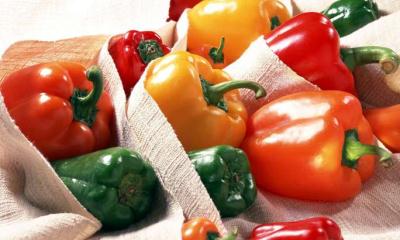 Carefully sorted bell peppers (fruits are selected according to degree of ripeness and appearance) are packed in thin paper (each fruit separately).
Carefully sorted bell peppers (fruits are selected according to degree of ripeness and appearance) are packed in thin paper (each fruit separately).- A layer (2-3 cm) of river sand or sawdust is poured onto the bottom of a wooden or cardboard box.
- Lay bell peppers in prepared containers in layers.
- The top layer is covered with sawdust or covered with sand.
Only a clean, well-ventilated garage or basement is suitable for storage. It is important that there are no fungi and mold on the walls of the room.
It is also necessary to ensure that the container in which the peppers are placed for ripening also has ventilation holes. Otherwise, the vegetable crop will rot very quickly, never reaching its tender stage of ripeness.
Adviсe
Before storage Each fruit must be carefully inspected for damage or spoilage.. Bell peppers with signs of rot or dents cannot be stored among the total mass of vegetables, since even one rotten fruit can ruin the entire harvest.
For ripening, it is better to leave late varieties of bell peppers (as an option, you can use the Lastochka, Novy Goshary, Beglitsky or Aristotle varieties). Unlike early varieties, late-ripening peppers will not become overripe or begin to rot by the time they are used.
Laying bell peppers for ripening, don't wrap it in old newspapers (vegetables become saturated with the unpleasant odors of printing ink). During long-term storage of vegetables, it is very important to periodically carry out inspections, removing spoiled specimens.
The video will show you how to organize the ripening of bell peppers:
Conclusion
By following the basic rules for ripening and storing bell pepper, you can enjoy its taste and beneficial properties for as long as possible.

